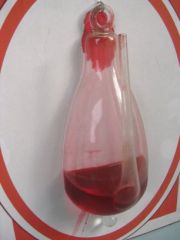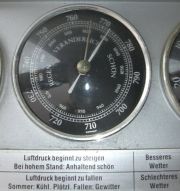
Goethe's Barometer
Goethe's Barometer is a very simple instrument and its readings are inaccurate.

Let us assume that pa denotes the atmospheric pressure at the moment of filling the barometer with liquid and Va denotes the volume of air in the bigger container at the same pressure. If the atmospheric pressure changes to the volume of px, the volume Vx (provided the temperature is constant) is:

The difference in the volume DV is the amount of liquid by which the volume in the bigger container increases/ decreases and it is:
which difference is balanced by the decrease/increase in the volume of the liquid in the other container. For example, we assume that the surface area in the bigger container is 50 times bigger than the surface area in the other one. If the level of liquid in the narrower container changes by for example 5 mm, it will change by 5/50 = 0.1 mm in the bigger one. Such a change is almost imperceptible. But we did not take into consideration the changes in temperature.
By contrast with Torriccelli barometer (see the picture), there is gas, not vacuum, in the closed part of Goethe's Barometer. The rise of temperature causes the gas expansion in the closed part. This in turn (at a constant external pressure) changes the readings.

The barometer's inaccuracy can be attributed mostly to the fact that there is water inside it, not oil with low compressibility of vapour. The pressure of water vapour increases with temperature non-linearly, considerably faster than the pressure of gas (dry, so called perfect), see the psychrometer.